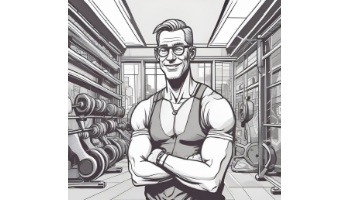 Have you ever witnessed an arm wrestling match between two opponents of similar strength? If you have then you have seen them, eyes bulging and veins popping, locked in place at the top. In such a case both wrestlers are exerting force but noone’s arm is moving. That is a great example of an isometric muscle contraction—the muscles are working like crazy, but nothing is moving.
Have you ever witnessed an arm wrestling match between two opponents of similar strength? If you have then you have seen them, eyes bulging and veins popping, locked in place at the top. In such a case both wrestlers are exerting force but noone’s arm is moving. That is a great example of an isometric muscle contraction—the muscles are working like crazy, but nothing is moving.
What Does An Isometric Contraction Do?
The most important job of an isometric contraction is to provide stability. In a nutshell, they do this by preventing movement from occurring at a joint. By holding stuff in place, isometric contractions keep your body from ripping apart.
A very simple and common example of an isometric contraction is your stomach muscle (rectus abdominis) when holding a plank. In the plank position, gravity is trying to pull the center of your stomach down towards the ground. The muscles of your abdomen contract to keep gravity from winning, holding you in a straight line with a flat back. That’s a common example, but a bit of a dull one. Let’s look at some more exciting ones:
The Shoulder In An Overhead Press
The shoulder joint is inherently unstable. That’s by design because it allows you to move your arm with great freedom. However, it also means that you need something to help stabilize it, which is where the rotator cuff comes in. The rotator cuff is a group of four tiny muscles surrounding the shoulder joint. They help move the shoulder yes, but they are even more important when they help the shoulder not move. In the top position of an overhead press you want your four rotator cuff muscles firing isometrically in order to keep everything locked in place.
Related: The Key To Overhead Work
The Forearms During Chin Ups
When you hang from a chin up bar you have to keep your fingers wrapped around it. This requires an isometric contraction from your forearm musculature. Without good forearm strength and endurance, you’ll be struggling just to hang on, which could be as big a factor in your chin up strength as the lats or the biceps.
The Biceps While Deadlifting
When most people think about deadlifting, the biceps probably aren’t the first thing to come to mind. But the biceps have a very important isometric role to play. When you deadlift a heavy weight, the biceps have to contract to keep your elbows and shoulders from being ripped out of the socket. That would definitely hamper your progress.
Related: Why Deadlifts Are Not Bad For Your Back
Isometric Contractions Have A Function
The main thing to keep in mind here is that isometrics have an important function. Some like to put isometric holds into their training because it burns, which feels like working hard, but this is just superficial. To get the most out of what they do, they should be put into the context of their function as a stabilizing force in the body.


